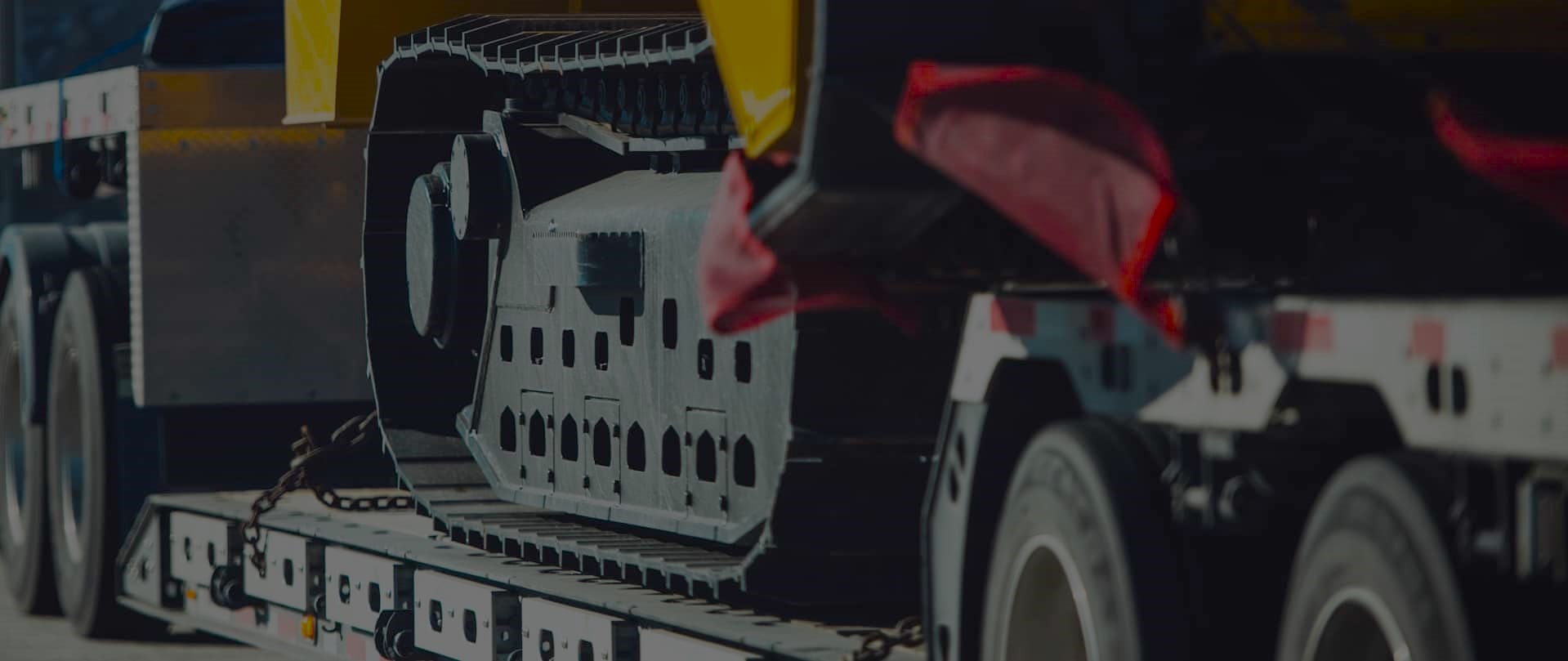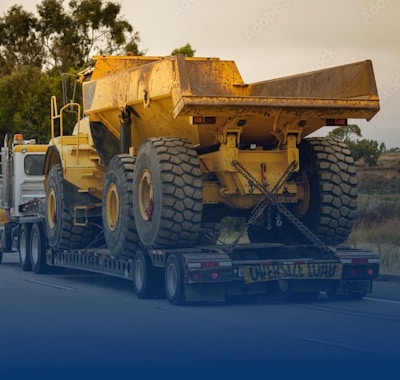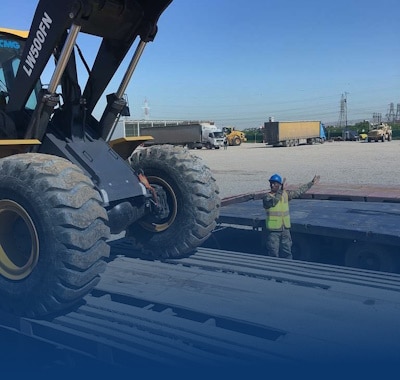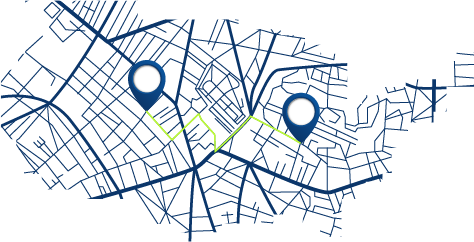Hauling Oversize Equipment Through Northeast City Traffic
Freedom Heavy Haul can offer expedited Pickup and Delivery for any size shipment anywhere in the USA. Contact us today for No Hassle, No Pressure Pricing.
Moving large loads in dense urban areas demands careful planning. Permits, timelines, and cargo protection hinge on accurate measurements. Widths over 8 ft 6 in, heights above 13 ft 6 in, lengths past 53 ft, or GVW above 80,000 lb all trigger special rules.
Urban corridors add curfews, travel windows, and escort requirements that vary by town and state. A tight route can force detours if a bridge or tunnel has low clearance. Even an extra inch may change permit needs or require escort vehicles.
This guide helps you plan a safe, compliant trip. Learn how to verify dimensions, pick the right trailer, and set staging times to avoid peak traffic. We also cover when adding a marine leg can cut permit friction and reduce exposure to urban congestion.
Seasoned freight partners, like Freedom Heavy Haul, report fast response and personal attention when shipping heavy machinery. Clear communication among drivers, dispatch, and escorts keeps permits valid and deliveries on schedule.
Why Northeast city routes raise the stakes for oversized loads
Dense urban grids combine tight geometry and shifting rules, raising the stakes for wide or heavy shipments. Effective planning must factor local curfews, peak traffic, special events, and seasonal bans such as spring thaw.
Physical constraints—low bridges, narrow turns, soft shoulders, and weight-restricted segments—often rule out preferred paths. Software helps, but human judgment and regional knowledge remain essential to verify the path against real-world obstacles.
Multi-layered regulations and permits change as you cross municipal lines, so compliance requires precise paperwork and clear communications. Last‑minute detours or unexpected work zones increase the chance of delays and fines, and that raises the operational impact beyond the truck to staging and site access.
- Dense corridors magnify small routing errors into costly schedule slips.
- Timing windows narrow because rush hours and events limit daytime moves.
- Ground truthing is critical—maps may not show utilities, tree limbs, or slopes.
- Experienced transportation partners reduce permit friction and on‑the‑road surprises.
Plan with accurate load data, build alternates, and add buffer time to stay compliant and keep freight moving smoothly.
What counts as an oversized load today
A few inches or pounds can change a move from routine to permit‑driven. Accurate, documented measurements define whether a shipment needs special handling and what rules apply.
Most jurisdictions flag loads that exceed common thresholds: 8 ft 6 in width, about 13 ft 6 in height, 53 ft trailer length, or 80,000 lb gross vehicle weight. Exceeding any of these limits typically triggers specific permits, allowed travel windows, and escort needs.
Common size and weight thresholds that trigger OS/OW rules
Confirm local legal limits for width, height, and weight at origin, destination, and along the planned trip. A few inches of extra height or width can change the escort configuration or close off bridges and tunnels.
Trailer selection and securement implications for heavy equipment
Trailer choice depends on actual size, weight, and center of gravity. Lowboys, extendable flatbeds, and modular SPMTs solve different clearance and turning challenges.
- Securement points: Verify rigging needs early to set axle spacing and clearances.
- Structural limits: Heavier loads require route checks for bridges and pavement.
- Compliance: Match your equipment and securement plan to permit requirements to avoid stops or re‑routes.
| Trailer Type | Best for | Clearance/Turn Advantage |
|---|---|---|
| Lowboy | Tall machines | Lower height, better center of gravity |
| Extendable Flatbed | Long loads | Adjustable length for turns and overhangs |
| SPMT / Modular | Very heavy, wide loads | Axle spacing control; spreads weight |
Challenges hauling oversize equipment on Northeast city routes
The work is a detailed process that combines timing, permits, and clear communication. Urban moves require tight sequencing to keep freight on schedule and crews aligned with local rules.
Dense traffic patterns, curfews, and limited staging space
Rush windows compress operations. Curfews and daylight-only rules shrink available time, which raises pressure on staging and inspections.
Limited curb space and crowded yards make securement checks and pilot car coordination harder. That can increase the chance of last-minute delays for the load and vehicles.
Pavement conditions, spring thaw bans, and construction choke points
Seasonal restrictions and utility work can cancel a planned path overnight. Construction zones often narrow lanes and change turning geometry.
Rutted surfaces, patched pavements, and raised manholes reduce usable clearance under a tall load and create stop-and-go hazards that lengthen delays.
Jurisdictional patchwork across states, counties, and cities
Crossing multiple authorities multiplies permit forms, signage expectations, and escort needs. Emergency rerouting isn’t simple; alternates must meet the same permit rules.
- Plan pre-vetted alternate routes and confirm law enforcement contacts.
- Treat the move as a coordinated transportation process with checkpoints.
Permits and regulations across states, counties, and townships
Permit authority follows the pavement: whichever body controls a road issues the permit and sets travel windows and rules.
State highways, county roads, and local streets each have different processes and fees. Local permits often take 3–5 days or longer to clear, and some offices require bonds, proof of insurance, or copies of state permits and driver CDLs.
State permits vs. local “locals”: who issues what and when
Start by mapping who “owns” each segment of your trip. That tells you whether a state, county, or municipal office issues the permit and what regulations apply.
Typical timelines, costs, and documentation requirements
Costs vary widely. Some jurisdictions use flat fees. Others bill by ton per mile for overweight moves. Payment methods range from online portals to checks or phone payments.
- Local turnaround often: 3–5 days or more; plan extra time for legacy systems.
- Common documentation: bonds, insurance certificates, CDL copies, and copies of state permits.
- Certain approvals may need civil engineers or local agency sign-off before finalizing a permit.
| Authority | Typical Lead Time | Common Fees | Documentation Needs |
|---|---|---|---|
| State DOT | 1–7 days | Flat fee or overweight per-mile | Route maps, vehicle specs, insurance |
| County | 3–7 days | Flat or per-ton charges | Bonds, local insurance, CDL copies |
| Municipal | 3–10+ days | Variable; may charge per-leg | Civil engineer sign-off, permits, proofs |
Tip: Align state-level permits with local approvals, standardize your internal request process, and track expiration windows to keep compliance intact and protect scheduled move dates.
Navigating New York City: permits, escorts, and timing windows
New York requires close coordination and precise approvals for large transports. Each trip segment can need its own paperwork and a specific travel period. Plan early to match permit windows and crew schedules.
Daily OD permits are required for each portion of a trip off the Truck Route Network—one inbound and one outbound. City permits last up to five travel days but authorize a single period: day or night. Vehicles over 80,000 lb must secure a special handling permit from MTA Bridges and Tunnels.
Route and geometric surveys
Loads over about 80 ft long, 12 ft wide, or 13 ft 6 in high typically trigger a route survey. Very large moves—over 130 ft L, 15 ft W, 15 ft H, or 180,000 lb—require a geometric survey that can take weeks to approve.
Escorts, signage, and communications
Night moves are common for vehicles wider than 10 ft or heavier than 80,000 lb. Confirm escort numbers, signage, lighting, and radio plans before departure. Dense traffic and tight staging mean you must align departure time, verified parking, and crew access with approved windows.
“Validate each turn radius and overhead clearance along the approved path to prevent last‑minute changes.”
- Permits: Obtain both inbound and outbound daily OD permits if required.
- MTA: Secure special handling early for >80,000 lb loads.
- Compliance: Document approvals and keep constant contact among driver, escorts, and dispatch.
Chicago as a cautionary comparison for low clearances and rail crossings
Chicago’s rail tangle creates frequent low bridges and surprise clearance issues that can upend a planned trip. The metro area has many less-than-legal-height bridges and clustered rail crossings that mapping tools sometimes miss. That mismatch increases the risk of unplanned detours and stops.
Rail lines often force 10–15 mile detours to find lawful crossings. Those added miles affect fuel, timing, and crew windows. Build that contingency into schedules and budgets.
Less-than-legal-height bridges and rail-related detours
Low clearances near rail yards can invalidate a seemingly safe path. Overpasses and underpasses create pinch points that require alternate corridors.
- Plan for extra miles: detours commonly add 10–15 miles.
- Jurisdictional complexity: city, county, and state permits may all apply within a short span.
- Keep a library: track known pinch points and historical workaround paths for repeat lanes.
Why route surveys and pole cars reduce last-minute reroutes
Physical verification is the best insurance for tall loads. Route surveys and pole cars catch overhead and lateral clearance issues that software can miss.
“Use pole cars for shipments over 13 ft 6 in high to validate clearances before you move.”
Coordinate permit paperwork, local contacts, and escort cars to shorten turn times. Tools like Oxcart help speed approvals, but do not skip physical checks. Lessons from Chicago apply to other legacy-road areas with similar age and density.
Route planning workflow that keeps freight moving
Good route planning begins with precise measurements and a clear securement plan before any mapping or permitting starts. This early validation saves time and prevents rejected permits.
Verify dimensions, weight, and securement before mapping
Confirm length, height, width, and gross weight first. Even a small variance can change permit requirements or escort needs.
Define securement points early so trailer choice and axle spacing match the load and cargo. Match documentation to those specs for faster approvals.
Evaluate infrastructure limits: bridges, grades, shoulders, and turns
Scan the full route for overhead clearances, bridge ratings, steep grades, and narrow shoulders. Include traffic patterns, curfews, and seasonal bans in your plan.
Use surveys, mapping tools, and real-time data to validate choices
- Combine software with field surveys—pole cars or drones catch obstacles maps miss.
- Sequence permits to match the approved path across state and local agencies.
- Define escort counts, staging sites, and radio protocols before departure.
- Build pre‑permitted contingency paths to reduce downtime if closures occur.
Track each step in a repeatable process so future moves save time and maintain safety across the transportation chain.
Escort vehicles, safety supervisors, and communication protocols
Consistent communications and trained lead cars make narrow turns and multi-lane merges manageable. Use a clear convoy plan that assigns roles before departure. That prevents confusion and keeps the move predictable.
When pilot cars are required and how many you’ll need
Many moves require pilot cars with flashing lights, signage, and radios to warn other drivers and guide the driver. Confirm thresholds with each authority so you assign the correct number and type of support cars.
Some intersections and downtown segments call for multiple escorts. Assign a safety supervisor or spotter for the trickiest parts to monitor clearances and lane control.
Radio coordination, incident response, and public safety
Equip all escort vehicles with radios and standardized call signs. Use short, consistent call-outs for hazards, lane changes, and approaching intersections to keep the convoy aligned.
- Pre-brief incident response steps for breakdowns, closures, or interactions with the public.
- Stage escorts where merges and turns are complex to manage traffic and protect workers.
- Document any in‑route adjustments and report them to dispatch to preserve permit compliance.
- Debrief after delivery to refine playbooks for similar moves and improve logistics.
“Treat escorts as a core safety layer — not an afterthought — to protect the public and your team.”
Train all participants on local signage, flags, and speed-control expectations. Good planning and crisp communications reduce risk and keep permits valid until the load reaches its destination.
Scheduling for curfews, peak traffic, weather, and buffer time
Timing matters. Plan departure so the convoy travels during lower volumes and within approved windows. That reduces stops, the chance of enforcement checks, and the risk of costly delays.
Daylight-only windows, weekend restrictions, and event blackouts can remove otherwise good dates. Confirm local permit hours and city event calendars before locking a schedule. If a storm or spring‑thaw rule appears, shift the plan early.
Build buffer time for permitting, staging, and last‑minute re-routes. Sequence fuel and rest stops to match legal travel windows. Sync crane or site appointments with approved travel times so idle freight costs stay low.
- Use traffic data: pick departure times that avoid peak congestion.
- Pre-approve alternates: ensure backups meet the same permit conditions.
- Daily checks: confirm weather, construction, and state restrictions before moving each day.
“Keep a single, shared ETA source so dispatch, drivers, and site teams pivot together.”
Bridges, tunnels, and overhead clearances in aging infrastructure
Structure type and posted restrictions shape how heavy transports move through older corridors. In many urban and legacy areas, low spans, narrow underpasses, and posted ratings force early decisions about what path a shipment may use. Louisiana demonstrates how bridge design affects fees and approvals—super loads can trigger ton‑mile charges and engineering reviews.
Small variances matter. Even an inch over a posted clearance or a few thousand pounds above a rating often leads to a denied permit or a long detour. Near Mississippi River crossings, time‑of‑day rules may limit travel to off‑peak windows to protect fragile spans.
Weight limits, structure types, and why small variances matter
Verify posted bridge weight limits and match axle spacing to preserve structures and keep compliance intact. Some bridges accept higher gross weight with an engineering plan; others do not.
Overhead utilities, tree limbs, and street furniture checks
Survey overhead cables, traffic signals, and tree canopies that mapping tools miss. Use pole cars where clearance risk is high and document any path changes.
- Confirm posted limits and understand structural assessments vary by span.
- Inspect for temporary gantries, scaffolding, and construction that reduce clearance.
- Coordinate with utilities for lifts or pruning when signals and wires block the way.
- Log verified clearances to speed future approvals and protect the load.
“Field verification prevents permit surprises—measure, test, and record before you move.”
When marine transport reduces complexity and cost
Marine legs can strip away many road-based hurdles and simplify long moves. Using waterways often cuts the number of required permits and reduces the need for multiple escort vehicles. That lowers direct fees and shortens coordination time.
Barges handle larger dimensions and heavier weights than many trailers. They also offer better fuel efficiency per ton-mile, which can shrink total transport costs for very large cargo.
- Fewer road restrictions: waterways bypass many posted limits and curfews.
- Higher capacity: barges accept wider, taller, and heavier loads with less special handling.
- Scheduling stability: marine legs avoid peak traffic and some seasonal road bans.
Blending a short overland leg with a marine segment often minimizes total cost and risk. Port-to-site planning still matters: confirm lift capacity, tide windows, and staging to keep handoffs smooth.
“Use marine routing to reduce exposure to low bridges, rail crossings, and narrow turns common in older urban corridors.”
| Benefit | Marine | Overland |
|---|---|---|
| Permit volume | Lower — fewer local permits | Higher — multiple agencies |
| Load capacity | Very large/heavy accepted | Limited by trailer and bridge ratings |
| Exposure to traffic | Low — avoids rush periods | High — urban congestion risk |
| Hand-off needs | Lift and tide coordination required | Often direct delivery, but may need escorts |
Plan integrated transport and documentation across carriers and terminals. Keep short overland contingencies ready for last-mile permits and escort needs at the destination.
Partnering with experienced heavy haul providers for smoother trips
, Rely on teams that translate technical route maps into safe, executable trips. A trusted partner handles permit sequencing across state and local offices so your planning stays predictable.
They verify load size and weight, pick the right trailer, and align escorts and safety checks to your time window. That reduces surprises and keeps freight moving.
Look for proof of performance. Shippers name Freedom Heavy Haul for fast callbacks, personal attention, and reliable delivery. Expert carriers also weigh marine transport options to lower road exposure and simplify complex transfers.
Good partners document changes in real time, limit risk to cargo, and keep the shipment compliant from start to finish.







